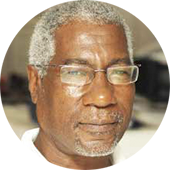
Big Money people have always wanted a piece of The Pitons – and many still do.
Back in the 1980s, agitation against a plan by potential investors to erect an aerial tramway across the summits of the twin peaks sparked the first case of a national concern to protect the new nation’s patrimony.
That cause was greatly helped by the involvement of highly-respected, top-notch Saint Lucians who saw the plan itself as an insult not just to Soufriere, but Saint Lucians — at home and abroad.
The plan so enraged Derek Walcott that he penned a poem likening it to an assault on ‘Helen’s Breasts’; and the likes of Fr. Patrick Anthony, artist Llewellyn Xavier (and many others) found the spiritual, artistic, cultural and political forms to encourage Saint Lucians to learn more about The Pitons – and why they should be protected.
After the tramway was stopped by public pressure, the Jalousie (Plantation) chapter of the unfolding pitons story featured the arrival of Lord Colin Tenant’s elephant from Bali; and another chapter involved artefacts from Jalousie that allegedly ended-up at a UK auction house.
After Tenant died, an associated Royal chapter involved lawyers for heirs and successors of Princess Margaret’s section of London’s royal household pleading with Tenant’s sole local heir (derisively referred to as his ‘man servant’ in the UK tabloids) to somehow, conscientiously bestow to Tenant’s former royal girlfriend’s heirs what the Lord chose not to.
The Tenant chapter also involved artefacts from the Jalousie plantation and the region between The Pitons, unearthed by or for Lord Tenant, that ended-up at a UK auction house.
The next chapter saw the Sugar Beach hotel constructed on the waterfront of the original Jalousie plantation, eventual problems with public access to the beach by land and fishermen complaining of being restricted in their seasonal net-fishing.
Then came the most important chapter of all: government’s move for designation of The Pitons as a World Heritage Site (WHS).
Under then Cabinet Minister Dr James ‘Jimmy’ Fletcher, a related public education drive was launched here while he led the campaign for UNESCO certification in Paris.
During that process, popular education included more and better understanding of the history of the Sulphur Springs, the historicity of Fond Gens Libre (Valley of the Free), how Saint Lucia’s First People used astrology and the Pitons to accurately tell time before Columbus came, the real story of the special hot baths constructed for a King Louis of France and about rum production at The Still, not too far from The Valley of Drunkards (Anse L’Ivrogne) at the base of one of the twin peaks.
But clearly, while citizens are caught with the romanticism of the Pitons as a natural tourism attraction, the world’s rich and famous have always kept their eyes fixed on them – from disgraced American billionaire Allan Stanford to Geoffrey Robillard, a senior vice president of the Montreal-based retail giant Dollarama Inc., the man at the center of the latest Pitons controversy.
During the operation for certification of The Pitons as a WHS, an announcement was made, under a UWP administration, that Oprah Winfrey was also allotted a Pitons lot, which remains undeveloped.
But it’s not only The Pitons, as the National Trust and other environmental activists were already making waves about sale of the large tracts of land on the East Coast for the Le Paradis project, the main bone of contention being its likely impact on the habitat of Frigate Birds species; and likewise the Trust’s opposition to the Dolphin Park proposed by the last administration, for which it was punished by government’s withdrawal of its $700,000 subvention (now restored); and likewise the Trust and Archaeological and Historical (A&H) Society’s opposition to construction of the Canadian-owned Cabot golf course on Amerindian burial sites.
In all these cases, however, the emphasis of the foreign press has been on ‘naming and shaming’ the entities and personalities involved, with local agitators preferring to tag-on to and share the publicity of the foreign press online, without giving equal thought and time to on-the-ground dissemination of information in the communities affected.
Saint Lucians know no more today than back then about the Frigate Birds or Fond Gens Libre, or earlier efforts to chart Soufriere’s architectural history with help from UNESCO and Cuba.
A Neg Mawon (Freedom Fighter) statue was erected in the Soufriere Square just before the 2021 General Elections, but with no connection made to the victory of the Freedom Fighters at the Battle of Rabot in 1795 when the Freedom Fighters defeated the British and abolished slavery here, albeit for one year.
Instead, Rabot is known today as the location of the island’s first foreign-owned chocolate factory, which revived the dying cocoa industry.
Fortunately, I’m not the only one alive who knows and remembers all the above, but unfortunately, too many have chosen to forget or erase those chapters of our history from their memory banks – and still too many through selective amnesia.
I interviewed Dr Fletcher last week about our continuing Pitons dilemma and among other things, he agreed that what’s badly needed is a continuous (year-round) environmental literacy campaign, that targets people and communities of interest and the population as a whole.
As things stand now, a handful of committed activists has been responsible for a growing international signature campaign with over 20,000 names and succeeded in restoring rough-riding public access to Anse L’Ivrogne Beach.
But there’s still much the government can do, starting with ensuring it takes the court’s advice to turn related ‘guidelines’ into ‘regulations’, ensuring its different departments’ reports to UNESCO are consistent, seeking UNESCO’ assistance in finding solutions that will avoid scrubbing of the limited WHS designation — and deciding on the costs and rewards of taking legal steps to reduce or erase future clashes between private development and protection of the national patrimony.












